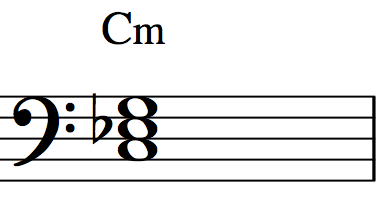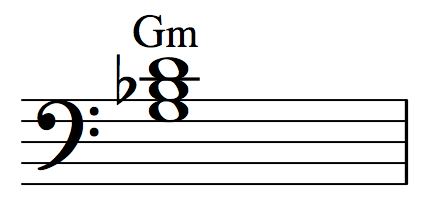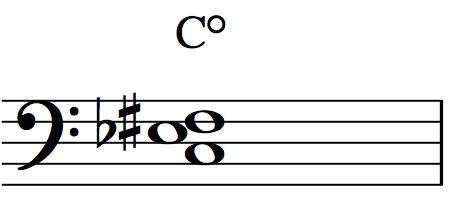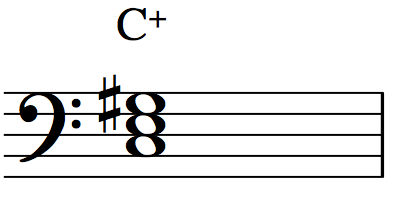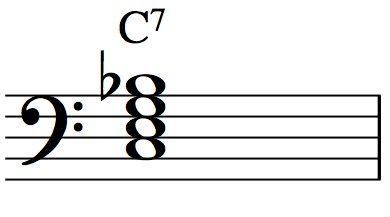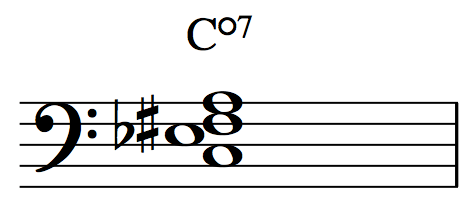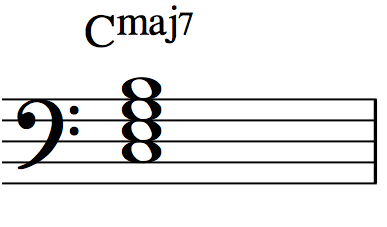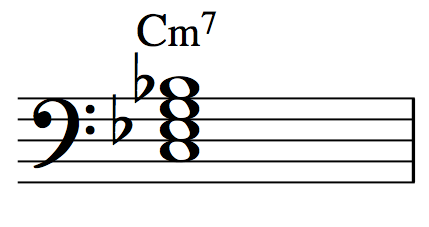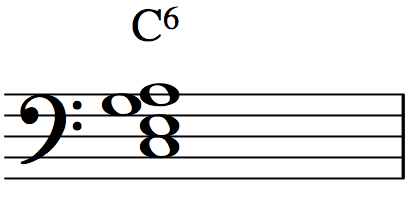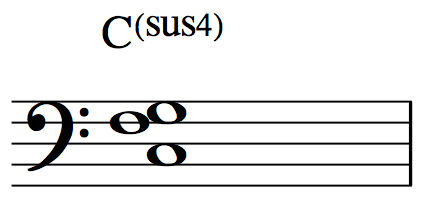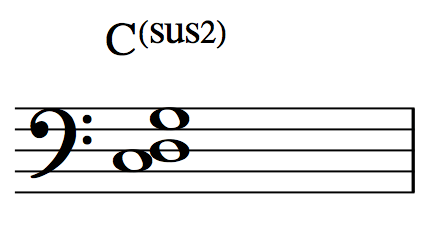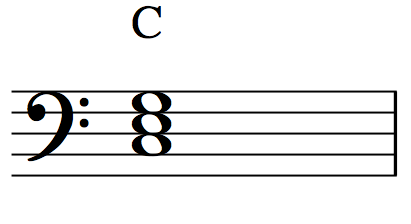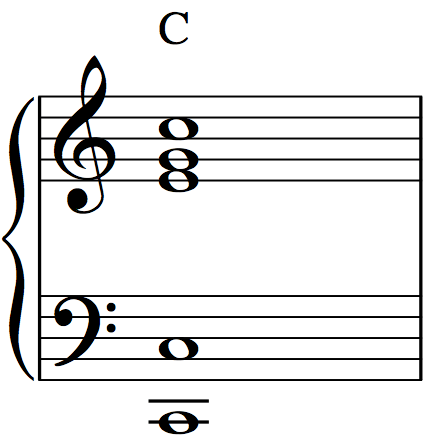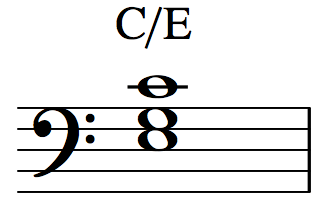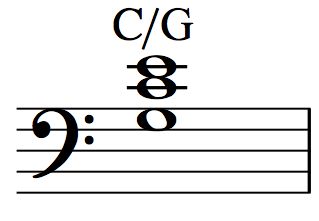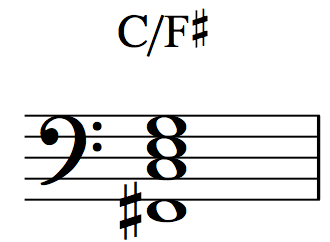An introduction to Reading Lead Sheets on the Piano or Keyboard - Part 2
Before proceeding, be sure you have read and understood lesson one, since we will be using the same method of finding chord shapes explained within that lesson.
Lesson one also introduced the most common chord shape when reading a leadsheet, the major chord. This lesson will introduce you to a number of other common chord types.
The minor chord ('m' or 'min')
A minor chord is signified simply by the letter 'm' after the note name, as in Cm, Dm, Ebm, F#m, Gm etc. Occasionally the 'm' will be written 'min', as in Cmin, Dmin, Ebmin, F#min, Gmin etc.
The chord shape is like that of the major chord except the middle note is one step lower. So, taking Cm as an example, in order to find this chord we first of all find the note C, then count three steps upwards (remember always to include black notes!) to Eb and then four notes to the note G.
Remember, with this, as with all the examples that follow, the same trick will work on any starting note, since each chord type will have the same shape. So, for example, to find Gm, we first of all locate the note G, then count up three notes to Bb, then four notes to D:
 Tip: Occasionally you will see major chords notated with an 'M', 'Ma' 'Maj' i.e. CM, CMa, CMaj. In order to differentiate, the minor chord is always be noted with a lowercase 'm'.
Tip: Occasionally you will see major chords notated with an 'M', 'Ma' 'Maj' i.e. CM, CMa, CMaj. In order to differentiate, the minor chord is always be noted with a lowercase 'm'.
The diminished chord ('dim' or 'o')
Written: Cdim, Ddim, Ebdim, F#dim, Gdim etc. OR Co, Do, Ebo, F#o, Go etc
Played: Taking Cdim/Co as an example, find the note C, then count up three notes to Eb and three notes to F#.
The augmented chord ('aug' or '+')
Written: Caug, Daug, Ebaug, F#aug, Gaug etc OR C+, D+, Eb+, F#+, G+ etc.
Played: For Caug/C+, find the note C, then count four notes to E and four notes up to G#.
Four-note chords:
The dominant seventh ('7')
Written: C7 D7 Eb7 F#7 G7 etc.
Played: For C7, find the note C, count four notes to E, three notes to G then three more notes to a Bb.
Hint: It may help to think of this as a major chord (C-E-G) with an added note (Bb).
The diminished seventh ('dim7' or 'O7')
Written: Cdim7, Ddim7, Ebdim7, F#dim7, Gdim7 etc. OR CO7, D O7, Eb O7, F# O7, GbO7 etc.
Played: For Cdim7/ CO7, find the note C, count three notes up to Eb, three notes up to F# and three notes up to A.
Hint: This is just like a diminished chord (C-Eb-F#) with and added note (A).
The major seventh ('Maj7' or 'M7')
Written: CMaj7, D Maj7, Eb Maj7, F# Maj7, GMaj7 etc. OR CM7, DM7, EbM7, F#M7, GM7 etc.
Played: For CMaj7/CM7, find the note C, count four notes up to E, three notes up to G and four notes up to B.
Hint: This is the same as the dominant seventh (C, E, G, Bb) except the top note is one step higher (C, E, G, B)
The minor seventh ('min7' of 'm7')
Written: Cmin7, Dmin7, Ebmin7, F#min7, Gmin7 etc. OR Cm7, Dm7, Ebm7, F#m7, Gm7 etc.
Played: For Cmin7/ Cm7, find the note C, count three notes up to Eb, four notes up to G and three notes up to Bb.
Hint: This is the same as a minor chord (C, Eb, G) with one added note (Bb)
The major sixth ('6', 'M6' or 'Maj6')
Written: CMaj6, DMaj6, EbMaj6, F#Maj6, GMaj6 etc. OR CM6, DM6, EbM6, F#M6, GM6 etc. OR C6, D6, Eb6, F#6, G6 etc.
Played: For CMaj6/ CM6/ C6 find the note C, count four notes up to E, three notes up to G and two notes up to A.
Hint: This is the same as a major chord (C, E, G) with one added note (A)
Suspended chords:
The suspended fourth ('sus4')
Written: Csus4, Dsus4, Eb sus4, F#sus4, Gsus4 etc. OR sometimes with brackets: C(sus4), D(sus4), Eb(sus4), F#(sus4), G(sus4)
Played: For Csus4 find the note C, count up five noted to F and two notes to G.
Hint. This looks a little bit like a major chord (C, E, G) except the middle note is one step higher (C, F, G). This gives a hint as to why it is called 'suspended' - because the F feels as if it wants to move to the more natural 'E' position to make a major chord.
The suspended second ('sus2')
Written: Csus2, D sus2, Ebsus2, F#sus2, Gsus2 etc. OR sometimes with brackets: C(sus2), D(sus2), Eb(sus2), F#(sus2), G(sus2)
Played: For Csus2 find the note C, count up two noted to D and five notes to G.
Hint. Again this is a little bit like a major chord (C, E, G) except the middle note is two steps lower (C, D, G).
The dash (/) and a word about chord spacing
The chords referred to here and in lesson one may be played in a number of ways.
For example, although a C chord (see lesson one) is defined as having three notes (C, E, G)...
...actually the notes can be played in any octave, so long as the note C is at the bottom:
However, sometimes you will see a chord written like this C/E or C/G. In those cases the letter after the dash refers to which note should be on the bottom of the chord. So C/E, in its simplest form would be like this:
C/G would look like this:
Less commonly, you will see notes that do not form part of the original chord in the bass. For example, C/F# would look and sound like this:
Now you've learnt to play chords, liven them up with this lesson on comping.

